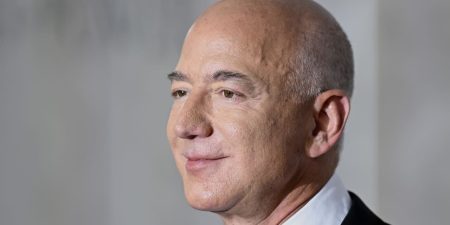Falling gasoline prices helped significantly slow the pace of price growth in October. While the Federal Reserve’s bid to bring inflation to 2% isn’t over, the cooling seen last month indicates the central bank’s policies are working.
The consumer price index, reported Tuesday by the Bureau of Labor Statistics, climbed 3.2% year over year in October—a slower pace than the 3.7% rate recorded in September and August. Economists surveyed by FactSet expected October’s inflation rate to slow to 3.3% year over year.
On a month-over-month basis, the headline index was flat. Economists forecast the pace of inflation would slow to 0.1% growth from the 0.4% monthly rate recorded in September.
Much of the slowdown in price growth was due to the gasoline index decreasing by 5% over the last month, following a 2.1% increase in September. Yet monthly shelter costs continued to tick up in October, offsetting the gasoline-price slump, according to the BLS.
Core prices, which exclude the more volatile food and energy indexes and are generally considered a better gauge of underlying inflation trends, also came in better-than-expected and showed continued cooling. October’s core CPI index rose 4% on a year-over-year basis, a slight slowdown from the 4.1% level recorded in September and the smallest 12-month change since September 2021.
Over the course of October, the core CPI measure rose 0.2%, slightly slower than September’s 0.3% monthly rate. Economists expected that core price growth would remain steady from September’s level of 4.1% year over year and 0.3% monthly.
The so-called supercore rate, or core services inflation excluding housing, came in at 0.2% for October, down from 0.6% recorded in September. The measure, which economists and Fed officials have zeroed in on in recent months as concern about services inflation have deepened, slowed to 3.7% year over year from 3.9% in September.
“With today’s CPI showing an overall decline in October, we expect inflation to continue to lower for the next few months driven by a noticeable downshift in consumption and softening demand,” wrote Matt Eagan, portfolio manager and co-head of the full discretion team at Loomis, Sayles & Company. “If this is the case, we could see inflation bottom with a 2% handle in the first half of 2024.”
The continued disinflation in the core measure, along with the significant slowdown in headline inflation, helps bolster the case for the Fed to skip increasing interest rates at its Dec. 12-13 meeting. The CME FedWatch Tool put the odds of no change to the Fed’s target rate in December at 100% after Tuesday’s inflation reading.
The Fed’s policy makers have stuck to a hawkish tone as of late and made comments about their desire to “proceed carefully.” But officials have a high bar to clear in making the case for the necessity of one more rate hike this year given the weaker October jobs report and other indicators that are pointing to slowing economic momentum.
“October’s CPI printed below expectations for both core and headline inflation, returning to the cooler inflation trend we saw over the summer,” writes Gargi Chaudhuri, head of iShares investment strategy within the Americas at BlackRock. He added that the latest inflation data confirms his expectation that the Fed will keep rates steady for the remainder of the year because “financial conditions are sufficiently restrictive and inflation is broadly heading in the right direction, albeit slowly.”
Of course, the Fed will have additional data—one more CPI reading and another jobs report, among other releases to consider—before its December meeting.
Stock prices leapt higher after the report, with a 2% gain on the
S&P 500
in late morning trading.
October’s significantly slower inflation reading might have come as a bit of a surprise to economists who expected higher reported levels due to residual seasonality and new data that was incorporated as part of the health insurance calculation. But neither shift meaningfully bumped up the inflation rates.
Moderating core goods prices, however, were key in offsetting moderate gains across core services prices. Following the trend of the previous several months, goods prices deflated 0.09% month over month. That was driven in large part by steeper decline in car prices, as well as in education and communication goods, writes Chaudhuri. While falling used-car prices have been a bright spot recently after the soaring costs seen during the Covid-19 pandemic, Chaudhuri expects this sector to provide less downward pressure on goods CPI going forward as price changes smooth out.
The “usual trouble spots” in both goods and services, such as motor-vehicle insurance and personal care, do still remain, writes Greg McBride, chief financial analyst at Bankrate. Shelter has accounted for 70% of the increase in core prices over the past year, but housing price pressures weakened in October 2023. The shelter index posted a monthly gain of 0.3% compared to September’s higher-than-expected 0.6% rate, the first significant slowdown recorded since March.
The BLS also reported real average hourly earnings on Tuesday. Adjusted for inflation, earnings increased 0.2% percent from September to October. Earnings increased 0.8% on a seasonally adjusted basis from a year prior.
The rise in real wages was offset by a 0.9% decline in the average workweek over the past year, which the Bureau said Tuesday could indicate that many workers likely saw no real change in their pay over the past 12 months.
American workers are continuing to experience positive real wage growth, however, which could help prop up consumer spending as purchasing power gradually recovers, writes Julia Pollak, ZipRecruiter’s chief economist.
“That boost should be enough to offset the cooling effect on consumer spending of the October student loan repayment restart and high interest rates on credit card debt and auto loans. Resilient spending should fuel continued job growth, and keep the long-predicted recession at bay,” she writes.
Write to Megan Leonhardt at megan.leonhardt@barrons.com
Read the full article here















